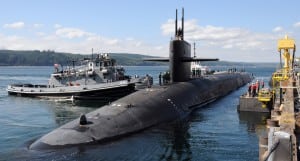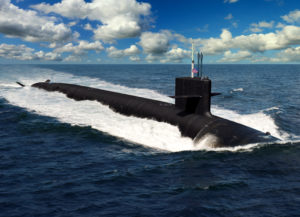Navy officials this week said the service plans to decide by fiscal year 2026 if it will extend the USS Alaska (SSBN-732) as the first of several Ohio-class ballistic missile submarines (SSBNs) getting limited life extensions starting in 2029.
Given the risks in transitioning from the 14-ship Ohio-class fleet to the 12-ship Columbia-class in the 2030s, the Navy is “evaluating some pre-inactivation, restricted availabilities, or PIRAs, on up to five Ohio-class SSBNs, the first of which would begin with USS Alaska in 2029. Nominally, an 18-month availability to give us about three years per hull of additional service life,” Rear Adm. Doug Perry, Director of Undersea Warfare (N97), said during the annual Naval Submarine League symposium on Nov. 1.

The Navy previously extended the life of the entire Ohio-class fleet from 30 to 42 years, but the service is now currently planning to extend between two and five of the submarines another three more years. This limited extension seeks to both add margin for construction of the Columbia-class SSBNs and to maintain at least 10 SSBNs able to go out on patrol.
The oldest of the 14 Ohio-class submarines is expected to reach the end of its service life in 2027.
During the symposium, Rear Adm. Scott Pappano, Program Executive Officer for Strategic Submarines, said before planning these extra life extensions plus an effort to procure future Columbia-class construction materials early, the Navy was not expected to consistently maintain at least 10 SSBNs for U.S. Strategic Command as they move from Ohios to Columbias in the 2030s.
“As I look through the 2030s and that transition, I am heel to toe, Ohio and the Columbia’s [coming] online. And our unclassified number that we talk about is the need to maintain 10 ships ready for sea, essentially strategically loaded to support the force commander, STRATCOM, to deliver strategic nuclear deterrence from the sea” throughout the 2030s, he said.
Pappano said the decision should be made by FY ‘26 because he needs enough time to allow the purchase of long-lead time material, make the commitment to buy that material, and get the facilities ready to maintain the extended ships with their weapons.
The Navy also needs to prepare for “any particular modernizations that are required, like we might have to look at can the combat system get to the new end of life or do I have to do some other modernization in our package” to allow time for future budget planning, Pappano told reporters during the event.
Pappano said the 2030s will be a risky transition point because it is “kind of a critical period with just new ships and just old ships,” which are the kinds that have the most problems.
He compared it to a car model that could have manufacturing defects when they are new, then the production model stabilizes, then older cars start having maintenance problems.
Perry also said the Navy is investing in an Integrated Enterprise Plan (IEP) to accelerate Columbia-class delivery by several months. With funding buy-in from the Defense Department, the IEP aims to fund shipbuilders to maximize facility usage, align resource planning and align execution to improve on-time delivery.
“With this effort, IEP, we estimate we’ll be able to accelerate the delivery of the Columbia-class hulls two through 12 by up to six months,” he said.

Pappano added the IEP specifically helps on material procurement, improving “the ability for the entire class to pull that long-lead time material to the left that would enable us to early up ship deliveries by about six months across the classes as a whole. And that was the most cost effective method of trying to mitigate the transition risk of Ohio to Columbia in the mid 2030s.”
On Tuesday Pappano also confirmed that as the early Ohio-class SSBNs and previously converted non-nuclear armed guided-missile submarines (SSGNs) are retired, the Navy will conduct destructive testing and cannibalization to get a better sense of how to extend the two to five retained SSBNs.
“I’m going to use those early ships to cannibalize parts, refurbish parts and give myself a stockpile, recapitalized attritable rotatable pools and other supply parts that I need on the shelf,” for the extended vessels, he said.
Pappano said the decision on how many Ohio-class vessels to retain is not concrete yet.
“So I think we’re going to need at least two or three, but we’re going to plan to do up to five. It is not an all or nothing decision, it is an incremental decision. So as the strategic landscape changes, as the world changes, as construction and performance changes, we can evaluate that going on,” he continued.
He confirmed there are no extension limitations based on the life of the nuclear reactor cores because “I have plenty of gas in the tank.”
Pappano would not tell reporters how much the PIRA extensions are expected to cost, but he said it is “not cost prohibitive” over a normal 18-month maintenance and modernization availability.
Perry added that if a submarine does not undergo the PIRA that does not mean it will be immediately decommissioned either.
“So there’s a balancing act on when you would decommission it, we will take that into account on what the costs are, what the availability of the shipyards are. The drop dead date on making that decision is also part of that, so that we don’t inject an unexpected or an unplanned perturbation into the shipyards, which we’ve talked about quite a bit. So we need to make the decision early enough so it’s part of a coherent plan,” he continued.
Pappano underscored the Ohio to Columbia time will also include a transition to the Trident D-5 Life Extension (LE) 2 nuclear missile at the same time, adding pressure to the need to maximize the number of operational SSBNs.
The ninth and later Columbia-class submarines will be outfitted with the D-5 LE2 missiles.
In the 2036 to 2039 timeframe “we have to be able to test that missile from both Ohio-class and in Columbia-class submarines. So, immediately, I take a ship off the firing line, which makes you want to have more than just 10 or 11, because I know there’s going to be a need.”